92.4K Subscribers
136 Videos
9.8M Views
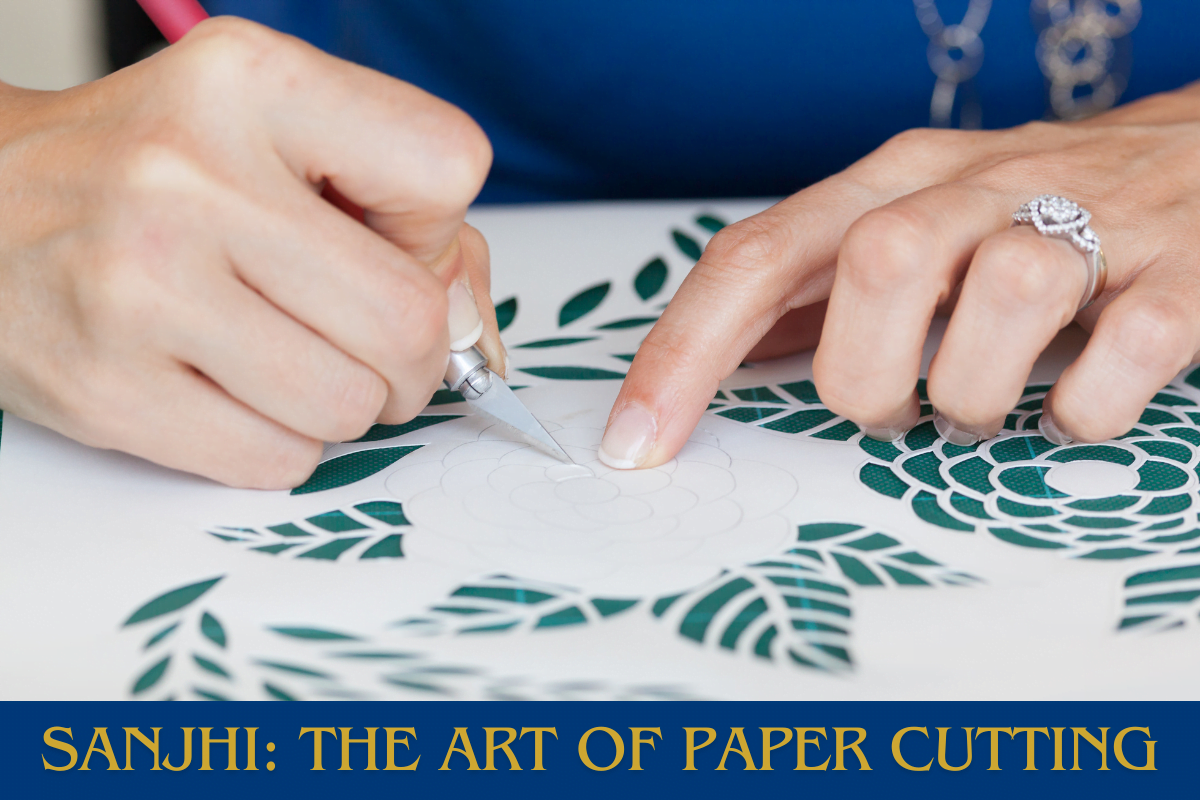
Origin:
Sanjhi is practised in Mathura and Vrindavan in Uttar Pradesh in India. Though the paper cutting work is done all across the world, Sanjhi is a little different. Sanjhi is said to have originated around 400-500 years ago in the 16th or 17th century. So like all the other Indian art forms I have shared here previously, this art form is also very ancient. Some craftsmen believe that Sanjhi word is derived from Saanjh or Shaam which means dusk, the time of day when temple floors are decorated using these stencilled papers and on the other hand, some craftsmen believe that Sanjhi word is derived from saaj-sajja or sajavat which means decoration because these papers are used to decorate temple floors.
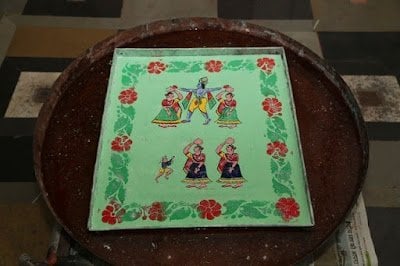 |
| Image Source: The Hindu |
Theme:
Since it is a traditional art form of Mathura, the birthplace of Lord Krishna, the theme mainly depicts the life of Lord Krishna and his leelas. Temple floors and walls are decorated using these stencilled paper and rangoli (powdered colors). This art form is highly refined, so it is mainly done by the Brahmin priests. Nowadays, only a few families, to be precise only 14 or 15 families, are there in Mathura and Vrindavan who practice this art. If you are interested in seeing Sanjhi in temples, then the Radharaman temple in Vrindavan is the place where you can see this art. It is believed that Radhe (Radha) used to decorate her walls and floors using colored papers, foils, colored stones, and flowers and leaves to woo Krishna, and then all the other Gopis followed suit. But during the Mughal period, the art form began to depict more scenes like Mughal architecture, floral and geometric patterns, and various other scenes.
Style:
Like I said earlier, it is an art of paper cutting, so only paper, specially designed scissors, and sometimes a blade is used to cut paper, and then intricate mythological figures, floral and geometric patterns are cut into the paper. And here, I would like to share an amazing fact that in its traditional form, craftsmen don’t draw or trace the design on the paper; they would just make the paper cutting directly on the paper, and it is done so precisely that you wouldn’t be able to find any flaw.
Here, I would like to mention two names who are still reviving this art form and keeping it alive. They are Mr Mohan Kumar Verma and Mr Ram Soni. They are fourth-generation Sanjhi artists.
Process:
The process is simple. I have divided it into two steps
1. Draw/trace/print the design on paper and
2. Start cutting the design
Below are the supplies you’ll need to make paper cutting artwork.
Supplies:
1. Paper
For paper cutting art, you will obviously need paper. It can be handmade paper, good quality printing paper, watercolor paper, or any paper from 100 gsm to 300 gsm. Remember, the thinner the paper is, the easier it is to cut, but that will increase the chances of making mistakes. The thicker the paper is, the harder it is to cut, but then there will be fewer chances of tearing the paper accidentally. I’m using 120 gsm A4 size scrapbooking paper.
2. Cutting Mat
You will need a self-healing cutting mat so that your work surface is protected. Otherwise, you’ll end up making the surface of your desk full of scratches. I would suggest you get the bigger mat as having a bigger cutting mat gives you enough working space and allows you free hand movement while cutting the paper. The mat given below has a grid and patterns marked on both sides. This is a must-have item for a crafter or for people who love DIYs.
3. Blade or Scalpel
You will need a scalpel for cutting paper. So make sure you have some spare blades, too, in case you need them during the process. Keep all the spare blades safe in a case to protect yourself from accidental blade cuts.
4. Pencil, ruler and eraser
You will need a pencil to draw a design on the paper and a ruler to cut straight lines.
1. Draw/trace/print the design on paper
Place the paper on the work surface and for design either you can draw your design like I did. If drawing isn’t your cup of tea, then below is the template for you to copy. Just download and print it. There are several other websites from where you can download free paper cutting templates (Google it). The printed side will be the wrong side, so make sure you print the mirror image of the design. The design is cut on the printed side of the paper, and the other side will be the right side where no pencil marks or print will be visible.
*Tip: Do not apply cream or moisturizer on your hands; otherwise, you’ll end up staining your paper.
I drew the fish with Pichwai lotuses especially for you all so that it is easier for you to start the paper cutting art with this easy template. All you need to do here is carefully cut out all the black or shaded parts of the design. For the outline of the fish, please draw one more outline as I forgot to click that picture, and while cutting that outer outline, leave some tabs too (Watch the video at the end of the article for clear instructions). Once you are confident enough to cut complex designs, you can start cutting the fish design with intricate patterns. All the instructions are given in a YouTube video.
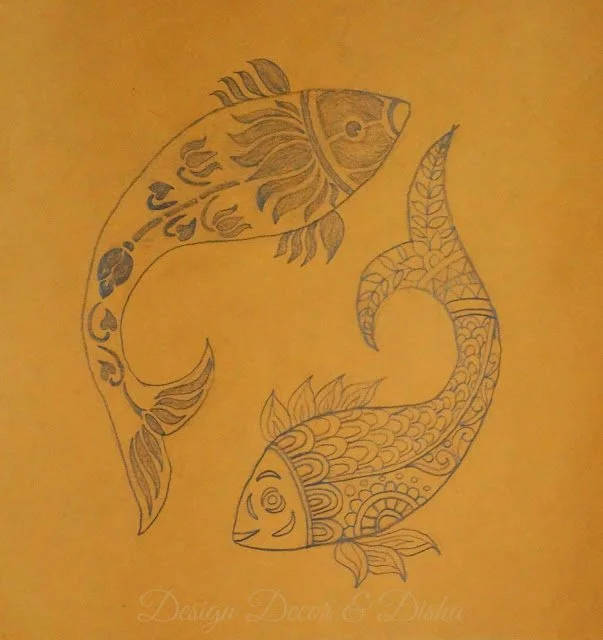 |
| Design Created by Disha Mishra Dubey |
2. Start cutting the design
Now, place the paper on the cutting mat and hold the knife like a pen and try to keep even pressure. Enjoy the process and relax. Don’t do it in a hurry. This process requires enormous concentration, patience and skills, but it relieves your stress, and you will love getting lost in it for hours. There’s no set way to learn paper cutting art. Keep practising, and you will learn it.
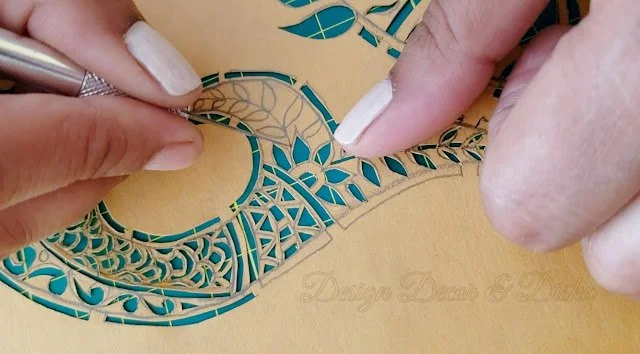 |
| Sanjhi – The Art Of Paper Cutting |
For cutting straight lines, you can use a ruler, but for curved designs, it is better to move the paper around. While making cuts, hold the paper with the other hand for better control. Cut the paper deeply enough that it goes through the paper but not too deep. Remove the pieces of paper as you cut them out. You can use the blade’s tip to lift the chip of paper and pull it gently with your fingers. If it doesn’t come out easily, then use the blade to cut the paper where it is stuck, and then it will come out easily.
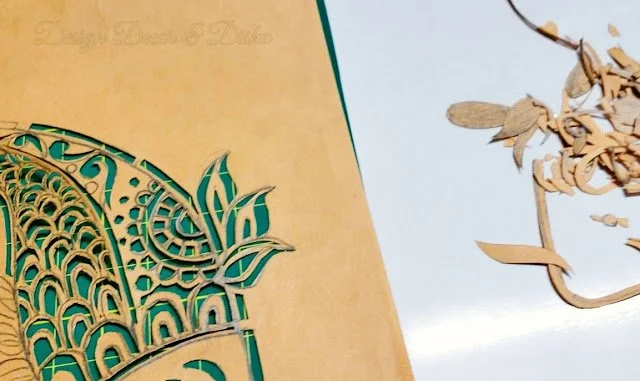 |
| Sanjhi – The Art Of Paper Cutting |
To cut complex and intricate patterns, cut as close as you can to either side of the pencil line. Do it slowly, and enjoy every bit of the process.
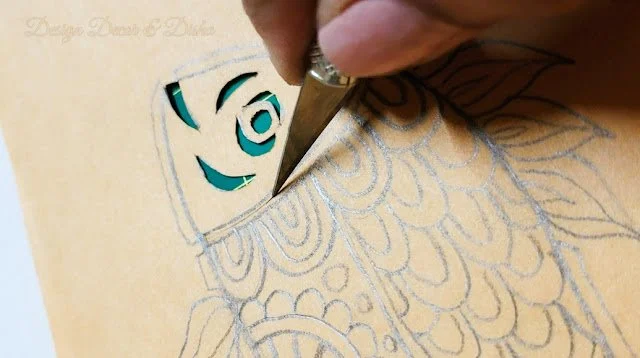 |
| Sanjhi – The Art Of Paper Cutting |
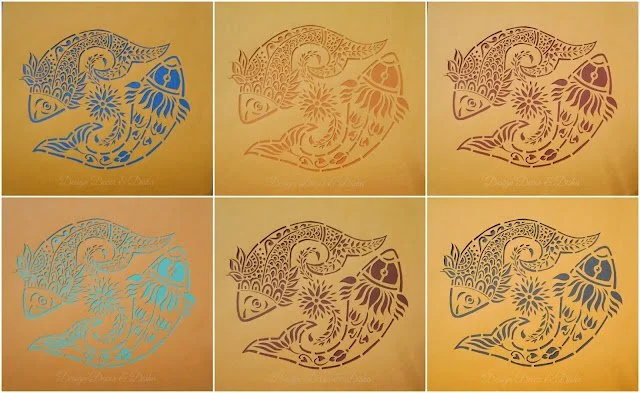 |
| (From top left to bottom right Sapphire, Ochre, Maroon, Cyan, Brown, Black) |
A Yoga mat can become a breeding ground for bacteria, so it's essential to clean it from time to time. Here's how I do it: * Take equal parts of water and white vinegar or liquid soap. * Fill the solution in a spray bottle and spray it on the yoga mat covering it entirely. * Let the solution sit for 10-15 mins and then rub it gently either with a soft cloth or sponge. * Rinse with tap water to remove vinegar. Do not scrub or squeeze the mat. * Hang or lay it flat to dry. Hope this helps :) #yogamat #yogamatcleaning #cleaningtips #howtocleanyogamat #diycleaningsolution
House to home makeover. It took a great deal of time and effort, but the result was absolutely worth it. #walldecor #wallstencil #wallpainting #homedecor #diy
I love how fresh and breezy the room looks now. #RoomMakeover #homedecor #decor #wallpaper
I’ve always been a creative person, it’s not just my passion, it’s also my profession. I love learning new skills and exploring new ideas. But over the past few years, due to some family responsibilities and other priorities; my work took a back seat. The creative spark within me had started to fade. Still, I tried to keep the fire alive. I kept learning new skills every time I got the opportunity. So, when I heard about ‘Elevate’, a five day watercolor floral workshop by Sushma Hegde, I signed up immediately. And what unfolded over the next five days was nothing short of magical. I got my mojo back, healed a part of myself, and felt my creativity soar again with new wings. A huge shoutout to Sushma for conducting these wonderful sessions. Her exemplary teaching methods and constant encouragement to paint every day made all the difference. I’m grateful beyond words. Here’s my journey from painting Geraniums on day-1 to painting Bouquet on the 5th and final day of the amazing workshop! Do you see any improvement in those days? Also, can you guess my favourite flower? . #artreels #watercolor #watercolorpainting #artist #floralwatercolor
I present to you a wall décor series filled with inspiring, real-world ideas. Read the blog below to see what homeowners have to say about decorating walls in a traditional Indian style. https://designdecoranddisha.com/wall-stories-traditional-indian-wall-decor/
Quick and easy Diwali rangoli. This Diwali, I didn't have much time to make rangoli so I made this quick and easy rangoli design in just ten minutes. . #rangoli #rangolidesign #easyrangoli #diwali #festivaloflight
Gond Art - Page-3 Coloring Book: Indian Folk Art - Adult Coloring Book Today I will paint the third coloring page of my Indian Folk Arts - adult coloring book. The first five colouring pages are dedicated to Gond art, a folk painting of Madhya Pradesh. Medium: Watercolor Art Supplies: All product links are saved under the "Art Supplies" highlight Brustro Watercolor Pan Set Watercolor Brush Pen Artline Fineliner pen Paintbrush no. 0, 2 Steps: Gond paintings don't usually have a colored background (it's left white, mostly) So I started by filling the main elements with vibrant colors. This time I chose just four colors to complete the painting. After filling in the colors, I drew the patterns like lines, dots and fish scale patterns using fineliner pens (black and red) and used white acrylic paint to paint dots using a 0-number paintbrush. Art Prints of this Unmukt Gond Art are available in different sizes on my website!!! #Indianfolkart #Folkart #Artist #watercolor #Gondart #Gondpainting #Folkpainting #Coloring #adultcoloringbook #coloringbook #artreels #Homedecor #coloringbookforadults #Gond #watercolorpainting
Gond Art - Page-4 Coloring Book: Indian Folk Art - Adult Coloring Book Today I will paint the fourth coloring page of my Indian Folk Arts - adult coloring book. The first five colouring pages are dedicated to Gond art, a folk painting of Madhya Pradesh. Medium: Watercolor Art Supplies: All product links are saved under the "Art Supplies" highlight Brustro Watercolor Pan Set Watercolor Brush Pen Artline Fineliner pen Paintbrush no. 0, 2 Steps: Gond paintings don't usually have a colored background (it's left white, mostly) So I started by filling the main elements with vibrant colors. After filling in the colors, I drew the patterns like lines, dots and fish scale patterns using fineliner pens and used white acrylic paint to paint dots using a 0-number paintbrush. Art Prints of this Sahastitva(Co-existence) Gond Art are available in different sizes on my website. #Indianfolkart #Folkart #Artist #watercolor #Gondart #Gondpainting #Folkpainting #Coloring #adultcoloringbook #coloringbook #coloringbookforadults #Gond #watercolorpainting

Don’t miss our future updates! Subscribe today!
© 2025 Design Decor & Disha. All rights Reserved. Designed and developed by Team Nirosha.
9 Responses
Saphire is looking natural with fish
Thanks for the suggestion 🙂
Wonderful art… Keep going!
Very nice Designs, please keep posting more articles like this. thanks
How much did it cost you to start up your website?
Hi to all, the contents existing at this web site are actually awesome for people experience, well, keep up the nice work fellows.
Hello! This is my first visit to your blog! We are a collection of volunteers and starting a new initiative in a community in the same
niche. Your blog provided us beneficial information to work on. You have done a extraordinary job!
Great article.
Enlightening and beautifully written